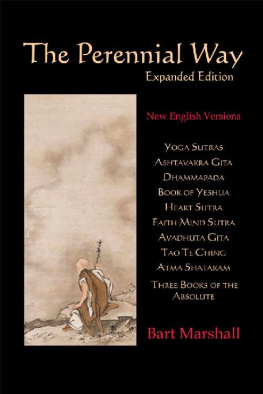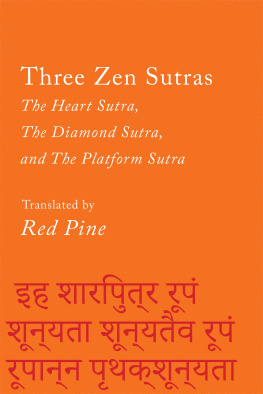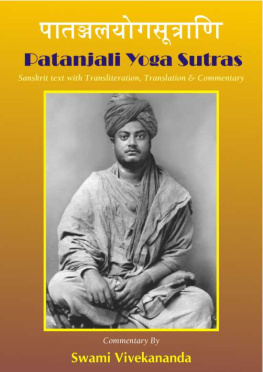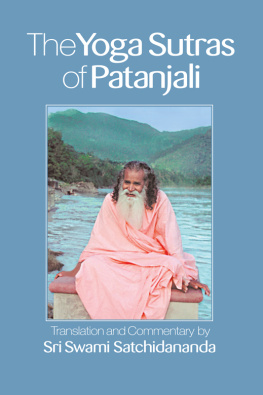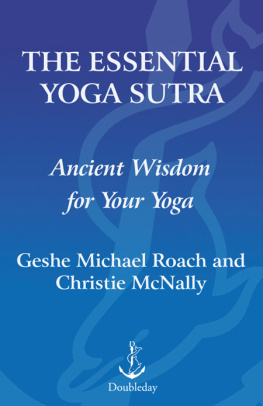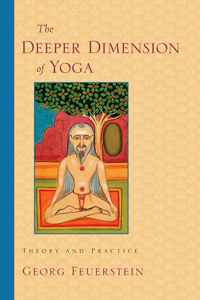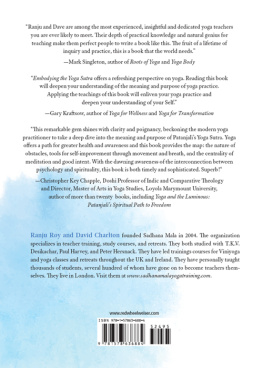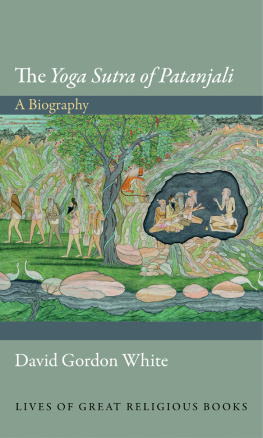The Perennial Way
Expanded Edition
Bart Marshall

The Perennial Way
Expanded Edition
New English Versions
Yoga Sutras
Ashtavakra Gita
Dhammapada
Book of Yeshua
Heart Sutra
Three Books of the Absolute
Avadhuta Gita
Faith Mind Sutra
Atma Shatakam
Tao Te Ching
Bart Marshall
Realface Press
Published by Realface Press
Raleigh, North Carolina
Contact:
Copyright 2009, 2016 by Bart Marshall
Expanded Edition 2016
All rights reserved. No part of this book may be reproduced or used in any manner without written permission from the author and publisher.
Text font: Book Antiqua
Main entry under title: The Perennial Way, Expanded Edition: New English Versions of Yoga Sutras, Ashtavakra Gita, Dhammapada, Book of Yeshua, Heart Sutra, Three Books of the Absolute, Avadhuta Gita, Faith Mind Sutra, Atma Shatakam, and Tao Te Ching
1. Spirituality 2. Philosophy 3. Religion
Library of Congress control number: 2016904591
ISBN: 978-0-9862035-2-7
There is one Way, no other.
It leads to the realization of Truth.
Enter the Way.
Gotama Buddha
Also by Bart Marshall
Christ Sutras: The Complete Sayings of Jesus from All Sources Arranged as Sermons
Contents

Preface to the Expanded Edition
In the seven years since publication of The Perennial Way, Ive been humbled and gratified by the reception it has received, and by the wonderful comments from readers about the essential place it has found in their lives and search for Truth.
I have also received suggestions about other spiritual works readers would like me to tackle in a similar way, most often the Bhagavad Gita, but also some lesser known works. I love the Bhagavad Gita and may indeed take it on someday, but it is too long to include in this Expanded Edition and needs a book of its own. Two other excellent suggestions, however, Avadhuta Gita and Atma Shatakam are found in this new edition, both ancient Advaita classics.
Ive also included two other works, Three Books of the Absolute, and Book of Yeshua. Three Books of the Absolute is an epic poem by the modern mystic Richard Rose that dramatically describes his Realization and what was realized.
Book of Yeshua contains selected sayings of Jesus of Nazareth, whos name, in his native language of Aramaic, is Yeshua. It is excerpted from my book Christ Sutras: The Complete Sayings of Jesus from All Sources Arranged as Sermons, and conveys the inner teachings of Jesus in his own words, teachings that are very similar to Advaita, Buddhism, and the other traditions anthologized here.
Readers have also asked why I havent pointed out the similarities between all these great teachings and provided commentary in the introductions. My feeling is that commentary often gets in the way of direct communion with the masters, and I wanted to present these works in such a way that they speak clearly for themselves with a powerful self-evidence that needs no commentary.
Better for you to discover for yourself the similarities between Jesus and Lao Tsu than for me or anyone else to point them out. Better for you to be caught off guard and struck speechless by a profound verse than for me or anyone else to tell you what to feel or hear in it, or worse, how to understand it.
There is nothing in these spiritual masterworks that you dont already know in the deep recesses of your heart and soul. Reading them is a journey into Self. Have at it, and Godspeed.

Introduction
In Vietnam when I was twenty-one a hand grenade or mortar roundcircumstances made it difficult to determine whichblew me into a clear and brilliant blackness that felt like home. For the next thirty-seven years that glimpse of infinite, intimate emptiness kept me looking almost obsessively in esoteric books, far corners, and inner reaches for an explanation of myself. Finally, at the age of fifty-eight, the veil suddenly lifted.
After a few weeks of blissful aftershock, life resumed. At the spiritual self-inquiry group Id been attending, friends naturally had questions. I found myself tongue-tied trying to answer. I struggled for words, or just stared ahead, choked up. The capacity to communicate does not come with the experience.
For several months after the occurrence I had no interest in readingor most anything else for that matterbut when I did start to pick up books again I found myself drawn mainly to the old masters. How did Buddha talk about This? How did Lao Tsu? Jesus? Patanjali? I read them with new eyes.
Oddly, in all those years of seeking I had never read the Ashtavakra Gita. But a year after seeking ended, at the bedside of my dying teacher, a friend placed it in my hands. I opened it and was astonished. Here, in one small book, was everything that needed to be said. Rather than stumble over my own words from now on I could just hand out copies and say, Here, read this.
At the same time, however, I was struck by the degree to which the language of the translation got in the way, how it obscured as much as it illuminated. I acquired all the other versions I could find and compared them, looking for the best. Literal transcriptions were valuable as reference, but required patient study to understand. English translations by Indian scholars made the meaning more clear, but tended to lack a certain rhythm and nuance of language I sensed in the original. Translations by native English speakers were better in this regard, but more likely to de-fang the teachings or just plain miss the point.
Somewhere along the way I realized I was hearing what I thought to be the clearest, most direct, most faithful translation of a verse and judging the others by it. I started writing down what I heard. The process was infectious. When Ashtavakra Gita was completed, I just kept going. Tao Te Ching came next, the first spiritual text to have a major impact on me as I began searching for answers, and perhaps one reason I later took Chinese as my language in college. I can no longer read Chinese, though, nor can I read Pali, or Sanskrit. I wish I could. It would be great to read these works as written. I found, though, that by studying and comparing a variety of English translations, as well as literal transcriptions and dictionaries, I was able to triangulate and reverse engineer back to the words and intention of the masters, then build back up again into what seemed (to me at least) the clearest, most faithful expression of the original.
Yoga Sutras, Dhammapada, Heart Sutra, Ashtavakra Gita, Faith Mind Sutra, and Tao Te Ching are considered by many to be the essential statements of Yoga, Buddhism, Advaita, Taoism, and Chan (Zen). It is to these traditions that serious seekers of enlightenment are generally drawn because they form the core methodology of a teaching we might call (to borrow from Huxley) the Perennial Way.
The Perennial Way points to something that cannot be seen, experienced, or spokencall it God, Tao, One, Absoluteand says it is possible to know It directly, to realize It as your true Self. The Way is not about beliefs or understanding. Its not ancient, not something to be studied like history or religion. What it points to is ever-presentthe Source of all that is. It speaks through those who enter It to anyone wholl listen and says, Come home.
Next page
